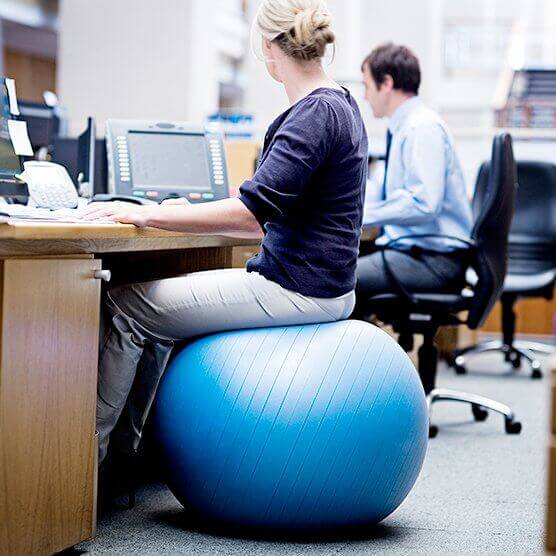I have lower back pain. Should I seat on a stability ball at the office?

With the increasing number of people working in an office nowadays, it’s more and more frequent to hear people complaining of a sore or tight back. In our practice, we’re often asked by people if sitting on a stability ball (or gym ball) would help their back pain.
What causes lower back pain?
Our lumbar spine (lower back) is a group of pilled bones (vertebrae) with intervertebral discs in between them, which are stabilised in a correct position by teamwork from some abdominal, back and pelvic muscles. These muscles have to work in synchronicity to achieve this goal, however, maintained sitting postures at the computer will lead to fatigue of some of these muscles leading to poor posture, which is less tiring for them, but bad for the health of the structures they are meant to stabilise. This is one of the reasons why sitting for long periods can lead to lower back pain.
Idea behind using a gym ball
The principle of sitting on a gym ball is that, by sitting on an unstable surface that keeps varying the gravity line of our centers of mass, we need to dynamically activate our core muscles in a more comprehensive way and, in some way, training them and getting them stronger.
Good, right? Well, not so fast..
Looking at the research done some years back, some articles suggested that there is no change in the activation of the abdominal muscles by sitting on a gym ball instead of an office chair. Some of them even show that this behavior was associated with discomfort1-7.
As the number of participants was low on those studies, in a more recent study by Elliott and colleagues (2016)8, more participants were included (90), which were asked to sit on a gym ball for 90 mins/day, 5 days/week for 8 weeks and looking to answer 2 questions:
Does a stability ball help to improve the function of the core muscles?
The results seem to suggest there is an improvement in terms of the abdominal muscles’ endurance, which is quite relevant as these muscles are meant to stabilise our spine, a job that requires them to be active through most part of our day, as opposed to being able to perform a very strong contraction.
Does it help improve lower back pain?
There was no evidence that sitting on a gym ball for a period of time at work would make a significant difference in terms of improving lower back pain, which may sound against the previous answer.
On another note, if your abdominal muscles are not very fit and you suddenly start asking them to maintain a contraction for a few hours every day, they will fatigue and will likely lead to more back pain. So, if you want to give it a go, DON’T ditch your chair and use the ball for periods no longer than 20 minutes, after which you go back to your chair, which should be adjusted to your height and tasks.
Posture while using the stability ball
It’s also crucial to choose a correct ball size and to keep it inflated at a good pressure, so that your posture won’t suffer from using the ball. As a reference, it’s important that your hips are slightly higher than your knees when you’re sitting, in order to maintain a good spine posture, that you have plenty of space under the desk to hold your legs slightly wider and also that your feet are firmly planted on the floor.
Keep in mind that, despite the improvement in your core muscles’ endurance, this core deficit may not be the only thing responsible for your lower back pain and you may need a more comprehensive approach in order to resolve the cause and symptoms related to your condition. Seeing a physiotherapist will help you to be more in control, to understand what needs improving in the performance of your spine control and to know if sitting on a gym ball at work is beneficial for you.
References:
- Gregory DE, Dunk NM, Callaghan JP. Stability ball versus office chair: comparison of muscle activation and lumbar spine posture during prolonged sitting. Hum Factors 2006;48:142 – 53.
- McGill SM, Kavcic NS, Harvey E. Sitting on a chair or an exercise ball: various perspectives to guide decision making. Clin Biomech (Bristol Avon) 2006;21:353 – 60.
- Marks C, Hylland K, Terrell J. Stability ball sitting versus chair sitting during sub-maximal arm ergometry. Int J Exerc Sci 2012;5:16 – 25.
- Weaver H, Vichas D, Strutton PH, et al. The effect of an exercise ball on trunk muscle responses to rapid limb movement. Gait Posture 2012;35:70 – 7.
- Ainscough-Potts A-M, Morrissey MC, Critchley D. The response of the transverse abdominis and internal oblique muscles to different postures. Man Ther 2006;11:54 – 60.
- Lowe BD, Swanson NG, Hudock SD, et al. Unstable sitting in the workplace – are there physical activity benefits? Am J Health Promot 2015;29:207 – 9.
- Abdon A, Vasconcelos R, Cunha L, et al. The effectiveness of the swiss ball treatment in schoolchildren with postural deviations. Revista Terapia Manual 2011;9:444 – 9.
- Elliott, T., Marshall, K., Lake, D., Wofford, N., Davies, G (2016), The Effect of Sitting on Stability Balls on Nonspecific Lower Back Pain, Disability, and Core Endurance – A Randomized Controlled Crossover Study, SPINE, Volume 41, Number 18, pp E1074–E1080
